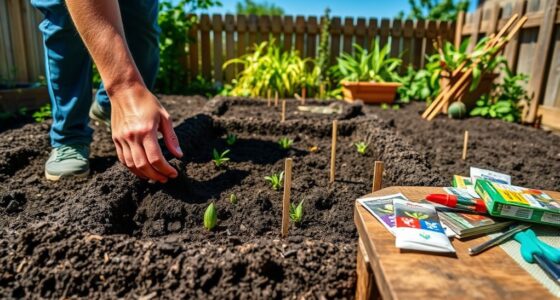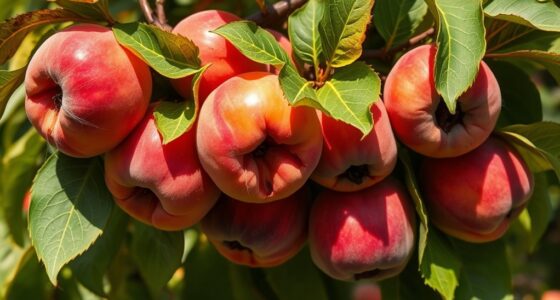Strawflowers, or *Xerochrysum bracteatum*, can act as perennials in ideal climates but are usually grown as annuals. They thrive in full sun and well-drained sandy soils. You'll want to water them weekly and ensure they get enough light for vibrant blooms. These flowers are drought-tolerant and attract wildlife like bees and butterflies. To get the most out of your strawflowers and learn more about their care, keep exploring the fascinating world of these unique plants.
Key Takeaways
- Strawflowers are typically grown as annuals, but can thrive as perennials in optimal climates and conditions.
- They prefer full sun, requiring 6-8 hours of direct sunlight daily for healthy growth.
- Ideal soil conditions include well-drained sandy or rocky soils with a pH of 5.5 to 6.5.
- Regular watering is necessary, with about an inch of water weekly, avoiding overwatering to prevent root rot.
- Monthly fertilization and deadheading spent blooms promote prolonged blooming and overall plant health.
Classification and Origin of Strawflowers

When you explore the classification and origin of strawflowers, you'll find that they belong to the Asteraceae family, scientifically known as *Xerochrysum bracteatum*.
Initially classified under *Helichrysum*, these vibrant flowers are native to Australia and have gained global popularity for ornamental use. European botanists first documented them in the late 18th century, quickly admiring their unique texture and bright colors.
Originally classified as *Helichrysum*, these Australian natives captivated European botanists in the 18th century with their vibrant colors and unique texture.
Thanks to their drought tolerance, strawflowers thrive in various climates. Taxonomic revisions based on phylogenetic studies led to their reclassification, but this hasn't significantly impacted cultivation practices.
Today, *Xerochrysum bracteatum* stands as the accepted name, reflecting their importance in horticulture and highlighting their enduring appeal.
Ideal Growth Conditions for Strawflowers

Understanding the ideal growth conditions for strawflowers is key to cultivating these vibrant blooms successfully.
These flowers thrive in full sun, requiring at least 6-8 hours of direct sunlight daily. While they can tolerate partial shade in hot climates, full sun yields the best results.
Ensure your soil is well-drained, preferring sandy or rocky types over heavy soils, with a pH of 5.5 to 6.5.
Watering weekly is recommended, but avoid overwatering to prevent root rot.
Strawflowers prefer temperatures between 65°F and 70°F during the day and around 60°F at night.
Lastly, monthly balanced fertilizer applications can enhance growth, and deadheading will encourage continuous blooming.
Support tall varieties to keep them upright and thriving.
Distinctive Plant Characteristics

Strawflowers showcase a unique blend of beauty and resilience, making them a favorite among gardeners. Native to Australia, these plants typically grow as annuals but can thrive as perennials in optimal zones.
Their flowers, resembling daisies, feature stiff, papery bracts that come in vibrant colors like yellow, orange, red, pink, and white. With a straw-like texture, these bracts retain their color and shape even when dried, making them perfect for arrangements.
Strawflowers are drought-tolerant and love full sun, thriving in well-drained soils. Growing between 1 to 5 feet tall, they can spread from 0.5 to 1.5 feet, attracting bees, butterflies, and birds, thus enhancing your garden's wildlife value.
Care and Maintenance Tips for Strawflowers

To keep your strawflowers thriving and vibrant, proper care and maintenance are key.
First, plant them in well-drained, sandy soil with a pH of 5.5 to 6.5, ensuring they get full sun. Space your plants 23-30 cm apart to avoid overcrowding.
Water deeply when the top inch of soil feels dry, providing about an inch of water weekly. Apply mulch to retain moisture and suppress weeds.
Fertilize monthly with a balanced flower fertilizer to promote blooming. Regularly deadhead spent blooms and pinch young plants for bushier growth.
Keep an eye out for pests like aphids or spider mites, and ensure good air circulation to prevent diseases.
With these tips, your strawflowers will flourish beautifully.
Uses and Benefits of Strawflowers

While you might admire their beauty in the garden, strawflowers offer a range of practical uses and benefits that extend beyond mere decoration.
Their vibrant colors and durability make them perfect for dried flower arrangements, wreaths, and garlands. If you're looking for long-lasting cut flowers, strawflowers are an excellent choice with a remarkable vase life. They're increasingly popular in wedding florals due to their unique appearance.
Once dried, these everlasting blooms can serve as cost-effective decorations for years. Additionally, strawflower oil boasts skin-regenerating properties and antimicrobial effects, providing health benefits as well.
Dried strawflowers provide lasting decorations and health benefits through their oil's skin-regenerating and antimicrobial properties.
Their drought tolerance and low maintenance make them eco-friendly options for your garden, supporting local biodiversity while enhancing your landscaping.
Cultivation Techniques and Varieties

When you're ready to cultivate strawflowers, understanding their specific needs can make a significant difference in your gardening success.
Start with well-drained, sandy soil and ensure a mildly acidic to neutral pH. They thrive in full sun but can tolerate partial shade. While strawflowers are drought-tolerant, consistent moisture boosts blooming. Aim for daytime temperatures between 65°F and 70°F, and apply a balanced flower fertilizer monthly.
For starting seeds, sow them indoors 6-8 weeks before the last frost in a quality seed starter mix, ensuring they get light for germination.
Deadhead regularly, stake taller varieties for support, and pinch young plants to encourage bushiness. With care, you'll enjoy vibrant blooms in various colors and heights!
Frequently Asked Questions
Can Strawflowers Survive Winter in Colder Climates?
Strawflowers can't survive winter in colder climates due to their lack of frost tolerance. If you live in a place with freezing temperatures, you'll need to treat them as annuals.
To protect them, consider using straw or frost cloth during harsh weather. Starting seeds indoors a few weeks before the last frost helps you get a jump on the growing season.
What Pests Are Common to Strawflowers?
In the garden, pests can be the unwelcome guests that wreak havoc on your strawflowers.
You'll commonly find grasshoppers, aphids, and leafhoppers munching away, while slugs and rabbits might sneak in for a nibble.
If you notice holes in leaves or wilting plants, it's a sign of trouble.
To keep your flowers vibrant, consider using neem oil or insecticidal soap, and don't forget to regularly check for infestations!
How Fast Do Strawflowers Grow From Seed?
Strawflowers grow pretty quickly from seed. You can expect seedlings to emerge within 7-10 days if you keep the soil moist and provide plenty of light.
Once they're ready, transplant them outdoors after the last frost, spacing them 9-12 inches apart. Typically, they mature in about 75-85 days, reaching heights of up to 4 feet.
Just make sure you give them the right conditions to thrive for the best results!
Are There Any Toxic Effects of Strawflowers on Pets?
Strawflowers are generally safe for pets, as they're non-toxic to both cats and dogs.
You don't have to worry about serious health issues, but if your pet eats a large amount, it might cause mild gastrointestinal upset.
Just keep an eye on them, since any plant material can lead to vomiting or diarrhea.
Can I Grow Strawflowers Indoors Successfully?
Can you imagine a vibrant bloom brightening your indoor space? You can definitely grow strawflowers indoors successfully!
Start seeds 6-8 weeks before the last frost, using a well-draining mix and providing plenty of light. Keep the temperature above 70°F for optimal germination.
Once seedlings are ready, harden them off before transplanting. With the right care, you'll enjoy their beautiful colors and unique, everlasting blooms throughout the growing season!
Conclusion
In conclusion, strawflowers bring vibrant color and unique texture to your garden, but are they truly perennials? While many may treat them as annuals, their resilience can surprise you. With the right care and conditions, you can enjoy these beauties year after year. Whether you're using them for fresh arrangements or dried displays, the joy of growing strawflowers is undeniable. So why not give them a try and see how they can brighten your space?










